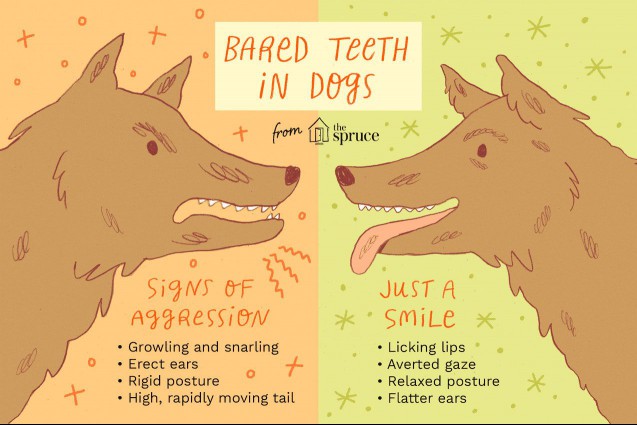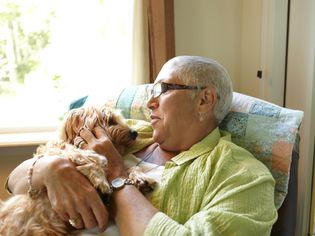Dog Body Language: Bared Teeth
You have probably seen a dog bare its teeth at one point or another. You might have thought it meant "stay away" and you were probably right. But what does it really mean when a dog bares its teeth? Do some dogs smile? If your own dog shows his teeth, is it aggression or is he smiling?
When a dog bares his teeth he is using body language to communicate. It's important to have some understanding of dog body language so you can understand what your dog is trying to tell you.
Definition
In dogs, the term "bared teeth" simply means a dog is showing teeth. A dog bares his teeth by curling his lips back to reveal his teeth. It is a reflexive action that occurs in reaction to certain situations. Bared teeth in a dog are often a warning.
Why Do Dogs Show Their Teeth?
In most cases, when a dog bares his teeth he is sending you a clear message to back off. Think of bared teeth as a warning: "I am going to use these teeth if you don't stop it." This behavior may be a precursor to more serious aggression. This type of dog body language is often accompanied by vocalizations, such as growling and snarling. You may also notice body language that indicates a dog is becoming aggressive, such as erect ears, a rigid body posture, and a tail that is held high and moving back and forth rapidly. If your dog's warning is ignored, the behavior could progress to snapping or biting.
Dogs display aggression for a number of reasons, such as fear, feeling overwhelmed, pain or anticipated pain, overstimulation, resource guarding, and territoriality. No matter the reason a dog becomes aggressive, bared teeth are usually a sign he is being pushed past his comfort zone. If you see a dog with this type of body language, it's best to leave this dog alone. Avoid eye contact and carefully step away from the dog.
Occasionally, a dog bares his teeth without any aggressive tendencies behind it. This is referred to as a submissive grin or a smile. It is usually accompanied by non-threatening body language such as lip licking, an averted gaze, a relaxed body posture, and ears sitting flatter against the head. The submissive grin is a type of appeasement gesture intended to calm down a situation. For some pets, the submissive grin can indicate stress and anxiety so it is important to always pay close attention no matter how long your pet has been doing it.
Many veterinarians associate averted gaze and lip-licking behaviors with stress and anxiety. If you notice averted gaze or lip licking in your dog during a presumed submissive grin, attempt to remove the stimulus that causes it as we always want to avoid encouraging stress or anxiety in our pets.
In general, submissive grins are not very common but for a few pets can be normal. However, if your dog is grinning because he is stressed or afraid, he could eventually feel threatened enough to get defensively aggressive.

The Spruce Pets/ Ashley Nicole DeLeon
How to Respond
If your dog is baring his teeth at you or someone else, take a look at his other body language. If you are uncertain of the cause or it appears that the teeth are bared in an aggressive manner, you should carefully remove yourself and/or your dog from the situation. Then seek the help of dog professionals, which may include a combination of a dog trainer, behaviorist, and veterinarian to rule out a pain-related/medical issue. You must act quickly before your dog bites someone.
If you are unsure whether your dog is exhibiting a submissive smile or becoming aggressive when he bares his teeth, your best bet is to call in the help of a professional dog trainer or behaviorist. These experts are specially trained to detect the most subtle clues in your dog's body language and behavior. It's always a good idea to put safety first.
If you feel absolutely certain that your dog is simply smiling and his body language otherwise appears submissive, you probably don't need to be alarmed. However, it is important that you keep watching your dog to determine if he becomes uncomfortable or nervous in his current situation. You should also keep observing to make sure you are not misreading the signs.
Training Dogs to Smile
In dogs that truly do smile, many owners are able to train their dogs to smile on cue. This is best taught by capturing the behavior and rewarding it while attaching a cue word like "smile." Just be absolutely certain that the dog is definitely smiling—and not showing aggression—before you teach your dog to do it on cue! Also, make sure you are not inadvertently reinforcing signs of fear or anxiety in your dog since some dogs will display this grin when they are nervous.
RECOMMENDED NEWS

Should Dogs Be Allowed on Furniture?
Should you allow your dog to get on the couch? Is it okay to let your dog sleep in your bed? Should

How to Train Your Dog to Live With Another Dog
When you add a second dog to your household, it's important to start things off right and allow it

Dog Training 101: How to Completely Train Your Dog
Are you ready to start training your dog or puppy? Proper training and socialization are among yo

Can Dogs Eat Yogurt?
Jam-packed with nutrients like calcium and protein, as well as probiotics that help support digesti

Are Bones Safe for Dogs?
Dogs love to chew on bones. And we dog lovers want to give dogs what they want. So, we often give o

Saying Goodbye to Your Dog
Whether you have an elderly dog or simply a dog with health issues, you are likely concerned about
Comments on "Dog Body Language: Bared Teeth" :